Haemanthus coccineus
| Botanical Name | Haemanthus coccineus |
|||||||||||
| Family | Amaryllidaceae - The amaryllis family. |
|||||||||||
| Pronunciation | hem-AN-thus kok-SIN-ee-us |
|||||||||||
| Common Name(s) |
English: April Fool; Blood Flower; King-of-candia; Paintbrush; Paintbrush Lily; Shaving Brush
Afrikaans: Bergajuin; Bloedblom; Bobbejaansool; Koning-van-kandië; Maartblom; Misryblom; Poeierkwas; Rooikwas; Seeroogblom; Skeerkwas; Skoensole; Velskoenblaar
IsiXhosa: umathunga; intlolokotshane; isititibala; inkuphulwana; umaweni
IsiZulu: Uzeneke
|
|||||||||||
| Plant Group |
|
|||||||||||
| Plant Size |
|
|||||||||||
| Position |
|
|||||||||||
| General Information |
|
|||||||||||
| Specific Information | Although the habitats of Haemanthus coccineus are widespread and variable, this plant is restricted to areas of winter rainfall with dry summers. It is dormant during the summer months when all above ground parts dry out, preventing moisture loss and stress on the plant. The flower head appears just before the rainy season is due to start and is soon followed by fleshy, translucent berries containing 1 - 3 pale to deep pink seeds. Once mature, the stem keels over and the seed germinates immediately, coinciding with the first rains. This adaptation allows the seedlings to grow strong enough to withstand the dry summer that follows. The two, or occasionally three, strap-like leaves, usually, but not always, appear after flowering has taken place. The leaves are highly variable in shape, size, colour and markings, being elliptical to strap-shaped, partially erect to prostrate, and most often with varying degrees of red or dark green markings on the undersides. The leaves die down from the end of winter to the beginning of spring. Haemanthus coccineus may be found growing in large groups, small clumps or as solitary plants. |
|||||||||||
| Ad Break | ||||||||||||
| Flowers | ||||||||||||
| Description | a flower head comprising of 6-9 stiff, spathe valves surrounding 25-100 tiny flowers, on a fleshy stem which may be reddish, or blotched, streaked or spotted with red markings, or occasionally unmarked |
|||||||||||
| Season |
|
|||||||||||
| Colour |
|
|||||||||||
| Growth Rate |
|
|||||||||||
| Plant Uses |
|
|||||||||||
| Distribution and Habitat | in the Western Cape, Eastern Cape and Northern Cape as well as southern Namibia, in predominantly winter rainfall areas, from sea level to 1 200m, with annual rainfall ranging from 100 - 1100 mm, in a wide range of soil types, in coastal scrub, on rocky slopes, Karooid veld, fynbos and Renosterveld, in rock crevices, shaded kloofs and on flats in the shelter of shrubs and bushes
|
|||||||||||
| Planting Suggestions | Haemanthus seeds have a very short viability period and should be planted as soon as they are harvested. Plant in deep seed trays as the young plants will remain in them for at least two years. Use a very well-drained, sandy medium mixed with some fine compost. The seed is pressed gently into the soil with just the top of the seed still visible. Water well and then withhold water until the first leaves appear, after which water the seeds well once every two to three weeks. At the approach of spring when the leaves begin to yellow, withhold watering altogether until the leaves reappear after the dormant summer period. After 2 - 3 years the young bulbs may be trans-planted. In areas other than winter rainfall regions it is best to plant Haemanthus into large, deep pots which will hold the mature plants, so that watering can be controlled. Haemanthus do not like to be disturbed so do not repot for some years and then only if the plants are showing signs of stress. Where plants are to be set out in the garden, careful thought must be taken before planting. Good drainage, some protection, visibility when in flower and a water wise position where the plants are not affected by artificial watering systems will need to be considered so that once settled, they are not disturbed. Good news for those gardeners plagued by the ever voracious molerats: the bulbs contain poisonous elements and are not eaten by these frustrating pests. |
|||||||||||
| Medicinal Uses | The sliced bulb, boiled in vinegar and mixed with honey, was used as a diuretic, as an expectorant and to treat Asthma. Fresh leaves were applied as a dressing to septic wounds, ulcers and sores and also to the pustules of anthrax. The bulb contains the alkaloide coccinine and should be used with caution as this substance has a known to cause convulsion. |
|||||||||||
| Ad Break | ||||||||||||


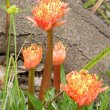
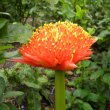
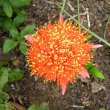
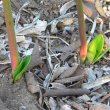
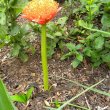


Discuss this plant
Share knowledge, ask a question or give an experience.